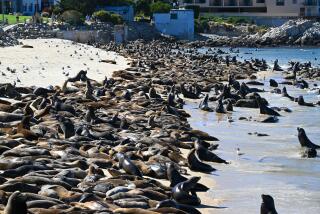Relocated Otters: 8 Die, 6 Leave Island, Many Others Unaccounted For
- Share via
SOUTH SAN FRANCISCO — Of 62 endangered sea otters moved from their native habitat to San Nicolas Island since August in a controversial government-sponsored relocation program, eight have died, six have left the area and 27 are unaccounted for, it was reported Tuesday.
Despite these seemingly discouraging numbers, biologists for the U.S. Fish and Wildlife Service defended the $1-million-a-year program before a California Coastal Commission meeting here.
The biologists said they had expected to lose some animals in the experimental attempt to establish a breeding colony of sea otters on San Nicolas, 70 miles southwest of Los Angeles.
“Sure we’re concerned; we wish there were 62 sea otters there,” said biologist Jim Estes, who is monitoring the relocation program. “But we’ve only been at this six months. We need more time with these animals.”
State and federal marine biologists said the program was necessary because sea otters could be threatened with extinction if their present breeding grounds off Monterey are hit with an oil spill or disease.
The otters in question are the first of several groups scheduled to be airlifted over a five-year period to San Nicolas, a former breeding ground of the animals that were hunted to near extinction before the turn of the century.
Biologists figured that the small, rocky isle was perfectly suited for the furry, 40- to 60-pound mammals. Owned by the U.S. Navy and sitting alone 55 miles southwest of Santa Catalina Island, its pristine coastal waters teem with the creatures’ favorite foods--abalone, crabs, lobster, mussels and sea urchins.
Still, they expected a few of the animals to die and others to try and swim away and possibly settle elsewhere, which worried commercial and sports fishermen who contend that otters decimate fishing grounds. But federal biologists pledged to keep track of the otters and return any that strayed outside the island’s waters.
Of the eight otters that died, three perished from stress related to the transfer, three drowned in lobster traps and fishing nets, one was shot and one was found dead of unknown causes.
On Monday, officials acknowledged that at least six otters have eluded recapture and managed to swim 150 miles home to Monterey. Another wayward otter was caught off the northern Los Angeles County coastline and returned to its original capture site, officials said.
“We do not see any colonization of sea otters outside of the management zone,” biologist Carl Benz assured the 12-member panel of commissioners.
Such pronouncements did not satisfy Clay Phipps, representing the Central California Council of Diving Clubs, which opposes the relocation program.
“Containment was promised,” Phipps said. “But it is pretty clear right now that the containment effort has not been working.”
Meanwhile, there are 27 otters unaccounted for--nearly all of them adults, officials said.
“We’ve lost most of the adults out there,” Estes said. However, he added, “we have only just begun to look for animals that have dispersed from the island.”
Estes also described problems with a radio tracking system used on some of the otters. He said two of the first 60 otters relocated between August and October had radio transmitters implanted into their abdomen. “One I never saw again,” Estes said. “The other remained on the island until January and then mysteriously disappeared.”
Two other otters, which were moved to the island more recently, were outfitted with tiny transmitters attached to identification tags placed on their rear flippers. However, Estes said, otters have been known to damage these instruments by trying to chew them off.
Some coastal commissioners were unsatisfied with the report.
“If things are not working as well as you planned, perhaps we should reconsider,” Commissioner Robert Franco said.
“I’m very unhappy that you stand here and tell us you cannot account for half the sea otters you took out there,” Commissioner Dorill Wright added. “I’m concerned about this experiment--and that’s purely what it is--and at some point you have to call it a bad experiment and move on.”
Commissioner David Malcolm, however, sided with the biologists.
“I’d hoped the numbers would be better,” Malcolm said. “Unfortunately, we are going to lose some animals in translocation. Fortunately, some are staying.”
Indeed, Estes said the remaining otters at San Nicolas have been seen feeding, rafting, grooming and breeding.
Carol Fulton, representing Friends of the Sea Otter, a Carmel-based group that claims 4,500 members nationwide and strongly supports relocation, said that while “we did not anticipate this many dead or missing animals . . . the issue has to be put in perspective.”
More to Read
Sign up for Essential California
The most important California stories and recommendations in your inbox every morning.
You may occasionally receive promotional content from the Los Angeles Times.














